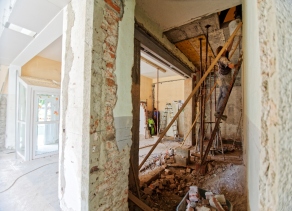 There’s no shortage of creative financing options available to investors, but one of the most popular methods to finance a real estate investment property is with the use of private or hard money lending. These lenders will look at experience level, financial history, and credit scores when determining if a loan scenario is a right fit for the company.
There’s no shortage of creative financing options available to investors, but one of the most popular methods to finance a real estate investment property is with the use of private or hard money lending. These lenders will look at experience level, financial history, and credit scores when determining if a loan scenario is a right fit for the company.
When lenders check a borrower’s credit score, usually with a hard tri-merge pull, it’s mainly focusing on the borrower’s ability to repay the loan based on their past financial history. Typically, credit score minimum requirements depend on the exit strategy of the real estate investment. For an investor who is fixing up the property for resale, the credit score may not be as big of a determining factor for LTV’s and interest rates. This compared to an investor who’s exit strategy is to refinance out of the hard money loan using a traditional lender, the credit score will be a significant factor in the loan approval process.
Generally speaking, Private Lenders are looking for a credit score above 600 but will consider credit scores around 575 and above depending on the reason for the scores level. So, before diving into the ways to improve your credit score to obtain the best LTV and interest rates, it’s important to understand how your credit score is determined. Credit scores operate on a scale range of 300 to 850, where 850 is the highest credit score that can be achieved. To achieve any score, credit is comprised of five elements, with some holding more weight (shown as the percentage below) than others;
-
Payment History (35%)
-
Amounts Owed (30%)
-
Length of Credit History (15%)
-
New Credit (10%)
-
Types of Credit Accounts (10%)
With the five elements that determine a credit score in mind, here are four simple ways to help increase your credit score;
- Check the Credit Report and Score
This may sound obvious, but it’s surprising how many people don’t actually know what their credit score is. In particular, when checking your score, it’s important to make sure there are no late payments incorrectly listed, and that the amounts owed (if any) for each of your accounts are correct. If you see any errors on the reports, dispute them immediately.
Before pulling a hard check on your credit that will affect the overall score, Bridge Loan Network offers soft credit pulls. Soft credit pulls have no effect on the credit score and will give the lender a general understanding of the credit score and if this is a scenario that makes sense for their company and the LTV and interest rates they can offer.
When the lender determines the borrower and the deal are secure, the hard tri-merge credit pull will still need to be on file, but if you are in the Bridge Loan Network portal, this score will last 90 days, and will not have to be pulled for every loan scenario you send to the lenders.
- Dispute Any Errors
Under the Fair Credit Reporting Act, both the organization that provided your credit report and the credit bureau are responsible for amending incorrect information on your credit report. It’s important to reach out to both parties with the information you believe is incorrect and clearly identify each item you are disputing, explain the facts around the error, and request it be deleted or a correction is issued. Also, in most states, you may be eligible to receive a free credit report from the credit bureau, once a dispute has been recorded, to verify your corrected information is listed.
- Pay Bills on Time
Payment history makes up 35% of your credit score. Late payments, even if they are only a couple days late, can have a major negative impact on the credit score. Setting up payment reminders with your card provider or adding reminders on your phone can help ensure no payments are missed. Most credit card companies have account settings to send alerts via text messages, emails or phone calls when a payment is coming due. You can also set-up your account to pay your balance every month, even if it’s just the minimum due, so you’ll never miss a payment again.
- Under-use the Card
Amounts owed is another major contributor, making up 30% of credit scores. It’s important to keep credit balances below 30% of the max limit of the account. Using even less will only help the score more. Some studies show that using your card at a 10% utilization ratio will have the most impact on raising the credit score.
Overall, private and hard money lenders may run credit checks to look for a borrower’s ability to repay the loan and credit score requirements can depend on the exit strategy of the investment itself. It’s important to know where you stand and how certain spending behaviors can affect your score.
Both soft and hard credit pulls are offered to all of our brokers on the Bridge Loan Network software. If you currently have these feature and are unaware of how to use them please reach out to our team for training. If you are interested in adding either of these features to your software, please again, reach out to a member of our team.
Submit a free inquiry and the opportunity will be matched with our qualified and approved hard money lenders. The simple application portal digitalizes the lending process enabling brokers and borrowers to upload needed documents, authorize credit checks and have a full loan package for our lenders to review. Apply now!
 Bridge Loan Network is excited to be attending and exhibiting at the upcoming National Private Lender Expo in New York. The Expo which is taking place May 16th at the Staten Island Hilton Garden Hotel is a one of a kind networking event where private lenders, investors, and mortgage brokers from across the country meet to discuss the commercial and residential real estate industry.
Bridge Loan Network is excited to be attending and exhibiting at the upcoming National Private Lender Expo in New York. The Expo which is taking place May 16th at the Staten Island Hilton Garden Hotel is a one of a kind networking event where private lenders, investors, and mortgage brokers from across the country meet to discuss the commercial and residential real estate industry.

 In a continued effort to provide superior customer service and product updates to our clients we launched our Broker User Survey earlier in the year to gain a greater insight into how we are doing.
In a continued effort to provide superior customer service and product updates to our clients we launched our Broker User Survey earlier in the year to gain a greater insight into how we are doing. When fixing and flipping or fixing and leasing real estate properties there are some important aspects to take into consideration before moving forward with the project. The fix and flip corner in real estate investing can be highly profitable for investors, but it’s important to choose your projects wisely so you do not overextend yourself and your resources.
When fixing and flipping or fixing and leasing real estate properties there are some important aspects to take into consideration before moving forward with the project. The fix and flip corner in real estate investing can be highly profitable for investors, but it’s important to choose your projects wisely so you do not overextend yourself and your resources. Top real estate professionals are always on the lookout for new tools and technology solutions to help their businesses gain a competitive advantage over their competitors. Plus, it’s also getting harder and harder to compete in the real estate industry without utilizing the right technology solutions.
Top real estate professionals are always on the lookout for new tools and technology solutions to help their businesses gain a competitive advantage over their competitors. Plus, it’s also getting harder and harder to compete in the real estate industry without utilizing the right technology solutions. There’s no shortage of creative financing options available to investors, but one of the most popular methods to finance a real estate investment property is with the use of private or hard money lending. These lenders will look at experience level, financial history, and credit scores when determining if a loan scenario is a right fit for the company.
There’s no shortage of creative financing options available to investors, but one of the most popular methods to finance a real estate investment property is with the use of private or hard money lending. These lenders will look at experience level, financial history, and credit scores when determining if a loan scenario is a right fit for the company. When investing in real estate, it’s important to have an exit strategy, in the overall plan. This is especially important when choosing to use a private lender for funding. For example when determining the exit strategy ask yourself; is this a property you want to renovate and sell as quickly as possible, or are you looking to hold the property as a rental and refinance with a conventional lender? These are the questions your lender is likely going to ask when determining if you are a qualified borrower, and how much they can lend on the project.
When investing in real estate, it’s important to have an exit strategy, in the overall plan. This is especially important when choosing to use a private lender for funding. For example when determining the exit strategy ask yourself; is this a property you want to renovate and sell as quickly as possible, or are you looking to hold the property as a rental and refinance with a conventional lender? These are the questions your lender is likely going to ask when determining if you are a qualified borrower, and how much they can lend on the project. Alright, you’ve done all the hard work and completed your latest fix and flip project. You’ve checked all the boxes on your rehab list, and it’s time to list the property for sale. Before you do, follow these four home staging tips and tricks to sell the flip quickly so you can get started on the next.
Alright, you’ve done all the hard work and completed your latest fix and flip project. You’ve checked all the boxes on your rehab list, and it’s time to list the property for sale. Before you do, follow these four home staging tips and tricks to sell the flip quickly so you can get started on the next. Now that the spring season is upon us, fix and flip investors are hard at work getting their properties ready. When getting your property market ready, many sellers will focus all their energy on the inside of the home despite the crucial role curb appeal plays in attracting potential homebuyers. First impressions matter whether online or in person, and curb appeal is one of the most important aspects that can determine how fast your flip sells.
Now that the spring season is upon us, fix and flip investors are hard at work getting their properties ready. When getting your property market ready, many sellers will focus all their energy on the inside of the home despite the crucial role curb appeal plays in attracting potential homebuyers. First impressions matter whether online or in person, and curb appeal is one of the most important aspects that can determine how fast your flip sells. In real estate investing, particularly fix and flip investing, choosing the right property to invest in can determine if the project will be profitable. So, before selecting a property to flip it’s important to know what the value of the home will be after renovations, or the After-Repair Value (ARV).
In real estate investing, particularly fix and flip investing, choosing the right property to invest in can determine if the project will be profitable. So, before selecting a property to flip it’s important to know what the value of the home will be after renovations, or the After-Repair Value (ARV). Before starting in real estate investing let’s go over some commonly asked hard money lending questions.
Before starting in real estate investing let’s go over some commonly asked hard money lending questions. 



